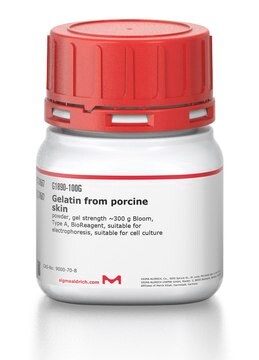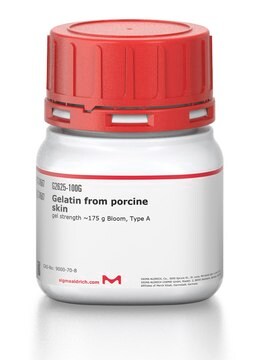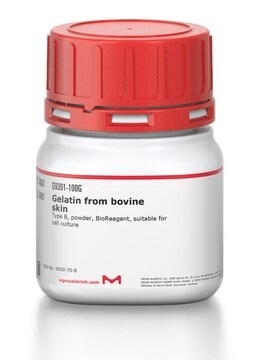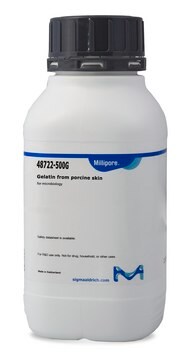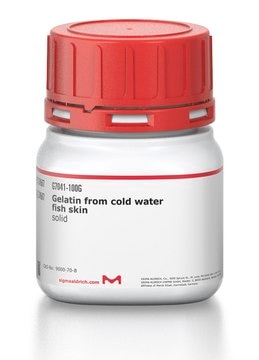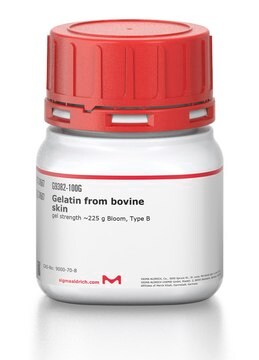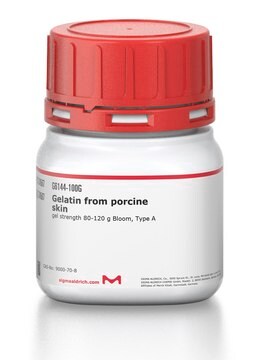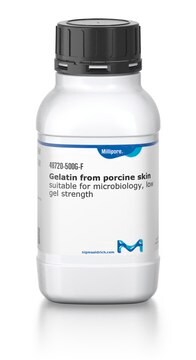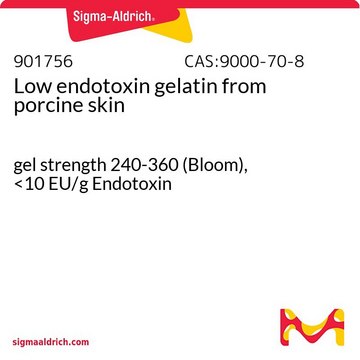G2500
Gelatin from porcine skin
gel strength 300, Type A
Sign Into View Organizational & Contract Pricing
All Photos(3)
About This Item
Recommended Products
biological source
Porcine skin
Quality Level
type
Type A
Assay
70-90% (biuret)
form
powder
technique(s)
cell culture | mammalian: suitable
gel strength
~300 g Bloom
solubility
H2O: soluble 50 mg/mL
Looking for similar products? Visit Product Comparison Guide
General description
Gelatin is a hydrocolloid. Bovine or porcine bone and hide are its commercial sources. It is a collagen derivative and comprises protein as a major component with minerals and water.
Application
Gelatin from porcine skin has been used:
- for coating glass-bottomed plates for culturing A375 cells and in gelatin degradation assay
- for coating glass slides in the histological studies with brain sections
- in the synthesis of gelatin methacrylate (GelMA) prepolymer for encapsulating cells on to 3D printed hydrogels
- to prepare thiol-functionalized gelatin (GelSH) hydrogel for 3D projection bioprinting
Gelatin from porcine skin is recommended for use as a cell culture substratum at 1-5 μg/cm2 or 0.5-50 μg/mL. The optimal concentration does depend on cell type as well as the application and research objectives.
Biochem/physiol Actions
Gelatin polymer is an alternative biomaterial to collagen for cell and tissue culture. It is a much sorted gelling agent useful as a thickener and food ingredient. Gelatin is also used as a foaming and binding agent and as well as in the pharmaceutical industry. It is biodegradable and biocompatible with biomedical applications especially in biomaterials for cardiac and vascular tissue regeneration.
Components
Gelatin is a heterogeneous mixture of water-soluble proteins of high average molecular masses, present in collagen. Proteins are extracted by boiling the relevant skin, tendons, ligaments, bones, etc. in water. Type A gelatin is derived from acid-cured tissue. Type B is derived from lime-cured tissue.
Caution
Dry gelatin, when stored in airtight containers at room temperature, will remain unchanged for many years. When heated at 100°C in the presence of air, it swells becomes soft and disintegrates to a carbonaceous mass with evolution of pyridine bases and ammonia.
Preparation Note
This product is derived from porcine skin. Gelatin is soluble in hot than in cold water. It is practically insoluble in most organic solvents such as alcohol, chloroform, carbon disulfide, carbon tetrachloride, ether, benzene, acetone, and oils. The Bloom number, determined by the Bloom gelometer, is an indication of the strength of a gel formed from a solution of the known concentration. The Bloom number is proportional to the average molecular mass. Bloom numbers of porcine skin Gelatin vary from 90 to 300 g. This product has a gell strength of 300 and is soluble in water at 50 mg/mL.
Storage Class Code
11 - Combustible Solids
WGK
nwg
Flash Point(F)
Not applicable
Flash Point(C)
Not applicable
Personal Protective Equipment
dust mask type N95 (US), Eyeshields, Gloves
Choose from one of the most recent versions:
Already Own This Product?
Find documentation for the products that you have recently purchased in the Document Library.
Customers Also Viewed
Gabriele Pitingolo et al.
Micromachines, 10(4) (2019-04-24)
Traditional two-dimensional (2D) cell culture models are limited in their ability to reproduce human structures and functions. On the contrary, three-dimensional (3D) microtissues have the potential to permit the development of new cell-based assays as advanced in vitro models to
Sami Zaqout et al.
Frontiers in neuroanatomy, 10, 38-38 (2016-04-12)
Golgi staining remains a key method to study neuronal morphology in vivo. Since most protocols delineating modifications of the original staining method lack details on critical steps, establishing this method in a laboratory can be time-consuming and frustrating. Here, we
Tissue-mimicking gelatin scaffolds by alginate sacrificial templates for adipose tissue engineering.
Nicola Contessi Negrini et al.
Acta biomaterialia, 87, 61-75 (2019-01-18)
When adipose tissue (AT) is impaired by trauma or disease, AT engineering could provide a shelf-ready structural and functional restoration as alternative to current clinical treatments, which mainly aim at aesthetic replacement. Yet, the lack of an efficient vascular network
R F Vogt et al.
Journal of immunological methods, 101(1), 43-50 (1987-07-16)
We tested instantized dry milk, casein, gelatins from pig and fish skin, serum albumin and several other proteins for their abilities to block non-specific binding (NSB) of a peroxidase-conjugated immunoglobulin to polystyrene microtiter plate wells. Each blocking protein was tested
Hand asepsis: the efficacy of different soaps in the removal of bacteria from sterile, gloved hands.
J P Gobetti et al.
Journal of the American Dental Association (1939), 113(2), 291-292 (1986-08-01)
The study showed that washing a gloved hand removed significant amounts of bacteria. If the proper soap or scrub is used, the gloved hand will be free of bacteria. It is suggested that all dental personnel wear gloves to protect
Articles
Papain is a cysteine protease of the peptidase C1 family. Papain consists of a single polypeptide chain with three disulfide bridges and a sulfhydryl group necessary for activity of the enzyme.
Our team of scientists has experience in all areas of research including Life Science, Material Science, Chemical Synthesis, Chromatography, Analytical and many others.
Contact Technical Service